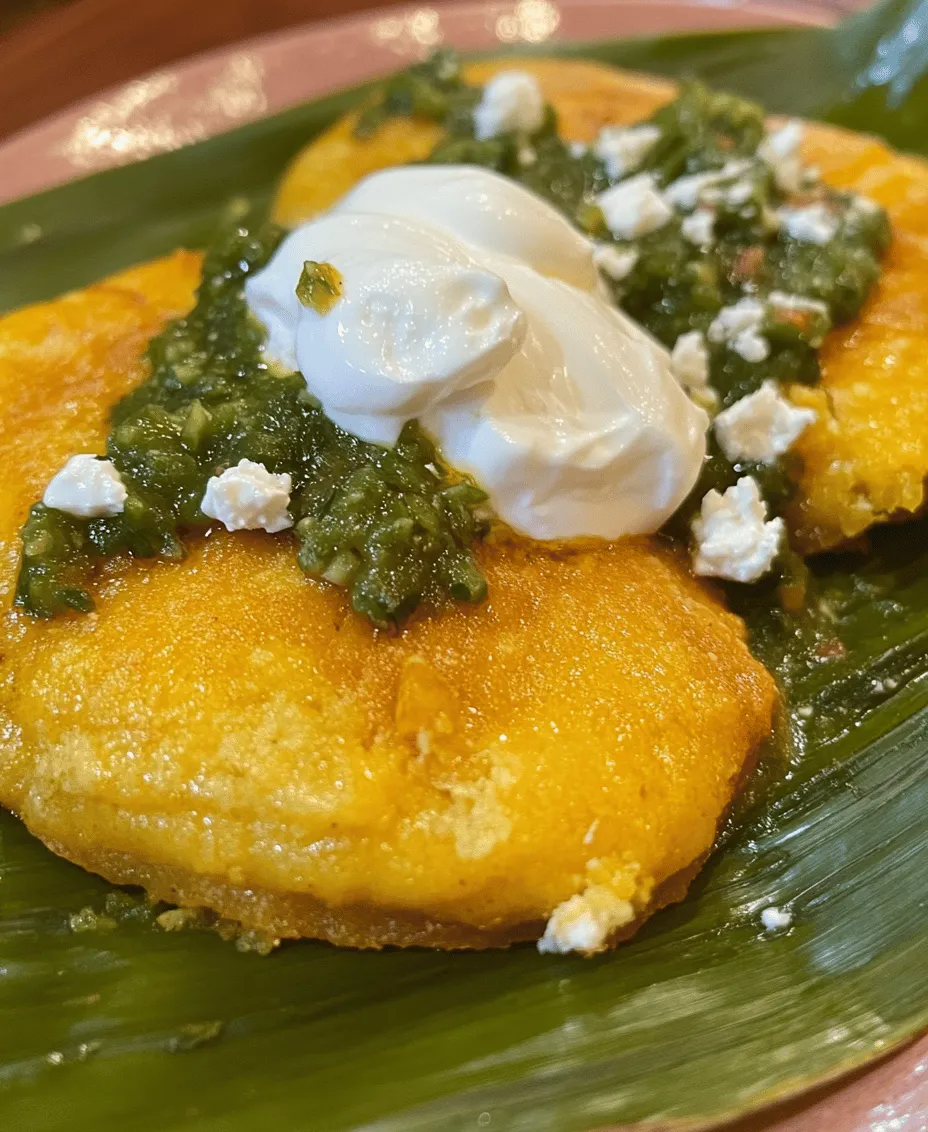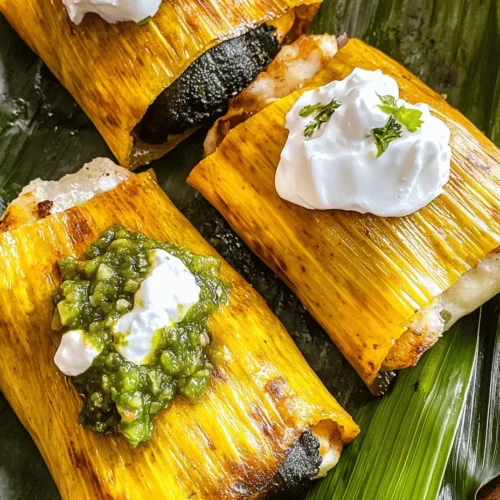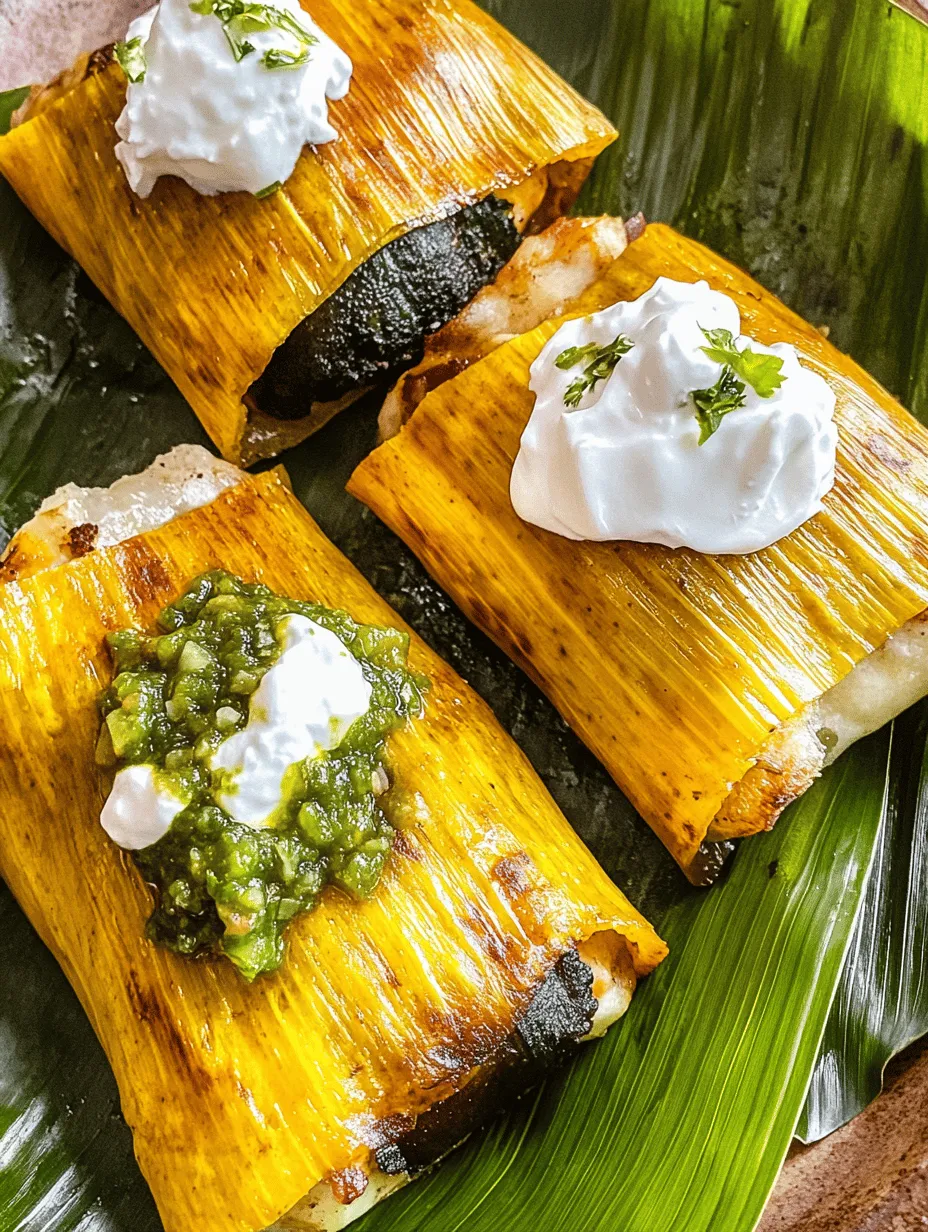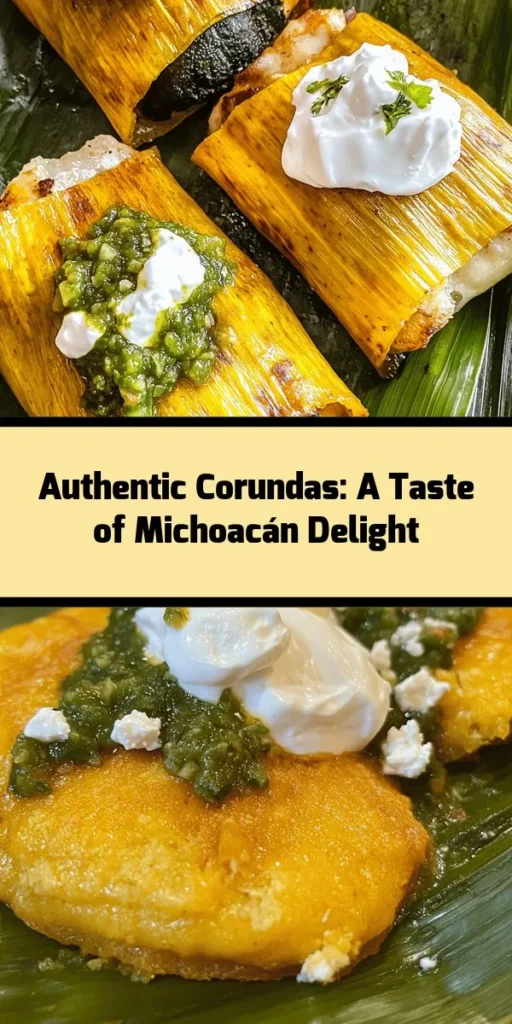Introduction
Michoacán, a picturesque state located in the heart of Mexico, is renowned not only for its stunning landscapes but also for its rich culinary heritage. The state is a melting pot of cultural influences, and its gastronomy reflects the diverse traditions of its indigenous peoples and Spanish colonizers. Among the many dishes that showcase Michoacán’s vibrant food culture, corundas stand out as a beloved staple. This traditional dish, often described as a regional cousin of tamales, serves as a testament to the ingenuity and resourcefulness of Michoacán’s cooks.
Corundas are not just food; they are a cultural emblem that represents the heart and soul of Michoacán. Traditionally made from masa harina, corundas are versatile and can be enjoyed in various ways—whether as a savory or sweet dish. The preparation of corundas is steeped in tradition, relying on specific ingredients that have been passed down through generations. Understanding the importance of these ingredients and the traditional methods of preparation is essential to appreciate the authenticity of corundas.
In this article, we will explore the rich history and cultural significance of corundas, delve into the essential ingredients that make this dish unique, and guide you through the step-by-step process of creating your own corundas at home.
Understanding Corundas
Definition and Cultural Significance of Corundas
Corundas are a type of masa-based dish that originates from the Purepecha people of Michoacán. They are often shaped like triangular parcels and wrapped in banana leaves or corn husks, which impart a distinct flavor during the cooking process. Corundas are typically served with various accompaniments, including sour cream and queso fresco, enhancing their flavor profile and texture.
The cultural significance of corundas goes beyond their delicious taste. They are often associated with communal gatherings and celebrations, making them a staple at family gatherings, festivals, and local markets. The act of preparing corundas can also serve as a bonding experience, where family members come together to share stories and traditions while cooking.
Historical Background of Corundas in Michoacán Cuisine
The history of corundas is intertwined with that of the Purepecha people, who have inhabited the region for centuries. Their culinary practices are deeply rooted in the agricultural traditions of Michoacán, where maize has been a dietary staple since pre-Columbian times. The use of masa harina—finely ground cornmeal—as the main ingredient in corundas reflects the significance of maize in Mexican culture.
In Michoacán, corundas have been enjoyed for generations, often finding their way into the kitchens of both rural and urban families. The dish has evolved over time, adapting to modern tastes while retaining its traditional essence. While corundas can be found throughout Mexico, the Michoacán version remains the most celebrated and authentic, often regarded as a symbol of the region’s culinary identity.
Comparison with Other Mexican Dishes like Tamales
At first glance, corundas may appear similar to tamales, another cherished Mexican dish made from masa. However, there are key differences that set them apart. While both dishes utilize masa as a base, corundas are typically made without fillings, resulting in a denser and more textured product. Tamales, on the other hand, are often filled with a variety of ingredients such as meats, vegetables, or sweet fillings.
In terms of preparation, the wrapping method also distinguishes the two dishes. Corundas are usually wrapped in banana leaves, which impart a unique flavor and aroma during steaming. Tamales, alternatively, are commonly wrapped in corn husks. This difference in wrapping, coupled with the absence of a filling in corundas, showcases the diverse culinary practices found within Mexican cuisine.
Ingredients for Corundas
To create authentic corundas, it is crucial to gather the right ingredients. Each component plays a vital role in achieving the perfect texture and flavor profile. Below, we break down the essential ingredients you’ll need.
Masa Harina: Origin and Importance in Mexican Cooking
Masa harina is a finely ground cornmeal made from nixtamalized corn, which means the corn has been soaked and cooked in an alkaline solution. This process not only enhances the nutritional value of the corn but also improves its flavor and texture. In Mexican cooking, masa harina is a fundamental ingredient used in various dishes, including tortillas, tamales, and of course, corundas.
The quality of masa harina directly affects the outcome of your corundas. Opting for freshly ground masa harina from local markets can elevate the flavor of your dish, making it taste even more authentic.
Warm Water: Role in Achieving the Right Dough Consistency
Warm water is essential in the preparation of corundas. It helps in hydrating the masa harina, allowing it to achieve the right consistency for kneading and shaping. The temperature of the water is important; using warm water helps the masa become pliable and easier to work with, ensuring that your corundas hold together during cooking.
Baking Powder: How It Contributes to Texture
Baking powder is another key ingredient that contributes to the lightness of corundas. While corundas are denser than tamales, the addition of baking powder helps create a slightly airy texture, allowing the corundas to rise slightly during cooking. This results in a more enjoyable eating experience, as the corundas are not overly heavy.
Salt: Enhancing Flavors
Salt is a fundamental seasoning in any dish, and corundas are no exception. A pinch of salt not only enhances the overall flavor but also brings out the natural sweetness of the corn. It is essential to find the right balance of salt to ensure that your corundas are flavorful without being overpowering.
Sour Cream: Traditional Serving Options and Variations
Sour cream is a traditional accompaniment for corundas, offering a creamy, tangy contrast to the dense masa. It can be drizzled on top or served on the side for dipping. While sour cream is a common choice, there are variations that include other types of sauces or salsas, depending on personal preferences and regional styles.
Queso Fresco: Significance of This Cheese in Mexican Cuisine
Queso fresco, a fresh, crumbly cheese, is another classic topping for corundas. Its mild flavor and creamy texture complement the dense masa, adding richness to each bite. Queso fresco is widely used in Mexican cuisine, and its role in enhancing the flavor of corundas makes it a must-have ingredient.
Banana Leaves vs. Corn Husks: Benefits and Traditional Uses
When it comes to wrapping corundas, the choice between banana leaves and corn husks can significantly affect the final product. Banana leaves are often preferred for their ability to impart a unique flavor and aroma to the corundas during steaming. They are also more pliable than corn husks, making them easier to work with.
However, corn husks are more commonly associated with tamales and can also be used for corundas in a pinch. The choice of wrapping material can be based on availability, personal preference, or traditional practices within specific families or communities.
Step-by-Step Instructions for Making Corundas
Creating authentic corundas at home is a rewarding process that allows you to connect with the culinary traditions of Michoacán. Follow these detailed steps to prepare your own batch of corundas:
Step 1: Prepare the Masa
1. In a large mixing bowl, combine 2 cups of masa harina with 1 teaspoon of baking powder and 1 teaspoon of salt. Mix the dry ingredients thoroughly to ensure even distribution.
2. Gradually add 1 cup of warm water to the dry mixture, stirring continuously until a soft dough forms. The dough should be moist but not sticky. Adjust the water quantity as needed to achieve the right consistency.
Step 2: Shape the Corundas
1. Tear or cut the banana leaves into squares (about 8 inches by 8 inches). If using corn husks, soak them in warm water for about 30 minutes to soften.
2. Take a small portion of the masa dough (about the size of a golf ball) and place it in the center of a banana leaf square. Flatten the dough into a triangle shape, ensuring the masa is evenly distributed.
3. Fold the sides of the banana leaf over the masa, creating a triangular pocket. Secure the edges by folding them down so that the masa is completely enclosed.
Step 3: Steam the Corundas
1. Prepare a steamer by filling it with water and bringing it to a boil. Place the wrapped corundas in the steamer basket, ensuring they are not overcrowded. You may need to steam them in batches.
2. Cover the steamer with a lid and steam the corundas for about 45-60 minutes. The corundas are done when they are firm to the touch and a toothpick inserted into the masa comes out clean.
Step 4: Serve and Enjoy
Once your corundas are cooked, carefully unwrap them from the banana leaves. Serve warm, accompanied by sour cream and crumbled queso fresco. Enjoy the authentic taste of Michoacán cuisine with each delicious bite.
This step-by-step process may seem involved, but the effort is well worth it. The resulting corundas are not only delicious but also a true representation of the culinary traditions of Michoacán. With the right ingredients and techniques, you can bring a taste of this vibrant region into your own kitchen.

Preparing the Masa: Techniques for Achieving the Perfect Dough
Creating the perfect masa is crucial for making authentic corundas. Start with high-quality masa harina, which is made from nixtamalized corn for an authentic flavor and texture. To prepare the masa, combine 2 cups of masa harina with 1/2 teaspoon of salt in a large mixing bowl. Gradually add warm water—about 1 cup—while mixing with your hands until a dough forms. The dough should be moist but not sticky; adjust the water as needed.
Kneading the masa for a few minutes will improve its elasticity. A well-kneaded masa will hold its shape during the cooking process, ensuring that your corundas are fluffy and tender. If you want to infuse a bit of flavor, consider adding a tablespoon of melted butter or lard to the mixture. This addition not only enhances the flavor but also improves the texture of the final product.
Shaping the Corundas: Tips for Flattening and Sizing
Once the masa is prepared, it’s time to shape your corundas. Begin by dividing the dough into equal portions, approximately the size of a golf ball. The size ultimately depends on your preference, but consistency is key for even cooking.
To shape each corunda, take one ball of masa and flatten it gently between your palms. You can also use a tortilla press to achieve uniform thickness. Aim for a thickness of about 1/4 inch. The traditional shape of corundas is triangular, resembling a small pyramid. To achieve this, fold the two sides of the flattened masa inward, creating a triangular shape. Pinch the seams to ensure they stay together during cooking.
Wrapping Methods: Importance of Proper Wrapping for Steaming
Wrapping your corundas properly is essential for achieving the desired texture during steaming. Traditionally, corundas are wrapped in corn husks, which not only prevents moisture loss but also imparts a subtle flavor to the masa. If using dried corn husks, soak them in warm water for about 30 minutes to make them pliable.
To wrap the corundas, lay a corn husk flat, place your shaped masa in the center, and fold the husk over the masa, ensuring it is completely encased. Tie the ends of the husk with a small strip of husk or kitchen twine to secure the corunda. This method allows steam to circulate evenly, ensuring that each corunda cooks thoroughly.
Steaming Process: Best Practices for Cooking Corundas Evenly
Once your corundas are wrapped, it’s time to steam them. Fill a large pot with water and place a steaming rack inside, ensuring the water does not touch the rack. Bring the water to a gentle boil. Arrange the wrapped corundas upright in the pot, making sure they are not packed too tightly. Cover the pot with a lid, trapping the steam inside.
Steam the corundas for about 30 to 40 minutes. To check for doneness, carefully unwrap one corunda; the masa should be firm and cooked through. If it feels soft or sticky, steam for an additional 5 to 10 minutes. Once done, remove the corundas from the pot and let them cool slightly before serving.
Serving Suggestions
Traditional Accompaniments: Sour Cream and Queso Fresco
Corundas are best enjoyed warm, straight from the steamer. Serve them with a generous dollop of sour cream and crumbled queso fresco. These toppings provide a creamy texture that complements the fluffy masa beautifully. Additionally, the contrast of the cool toppings with the warm corundas enhances the overall flavor experience.
Exploring Salsas: Differences Between Salsa Verde and Red Salsa
No Mexican meal is complete without salsa. For corundas, consider offering both salsa verde and red salsa. Salsa verde, made with tomatillos, cilantro, and lime juice, offers a tangy and slightly spicy flavor that pairs perfectly with the richness of the masa. On the other hand, red salsa, typically made with tomatoes, onions, and chiles, provides a smoky and savory contrast. Presenting both allows your guests to customize their meal according to their taste preferences.
Presentation Ideas for a Festive Meal
For a festive presentation, consider serving your corundas on a colorful platter garnished with fresh herbs, such as cilantro or parsley. You could also include slices of avocado or radishes for added color and texture. For special occasions, arrange the corundas in a circular pattern and drizzle with sour cream and salsa to create a visually appealing centerpiece.
Nutritional Information
Overview of Nutritional Benefits of Corundas
Corundas are not only delicious but also nutritious. Made primarily from corn, they are a good source of carbohydrates and fiber, providing energy and supporting digestive health. Corn is also rich in essential vitamins, such as B vitamins, which are vital for energy metabolism.
How Corundas Fit into a Balanced Diet
In moderation, corundas can fit well into a balanced diet. Pairing them with protein-rich toppings like sour cream and cheese, along with fresh vegetables, can create a wholesome meal. They can serve as a substantial side dish or a main course, depending on the accompaniments used.
Discussion of the Dish’s Vegetarian-Friendly Attributes
Corundas are inherently vegetarian-friendly, making them an excellent option for those following a plant-based diet. By using vegetable-based toppings and salsas, you can create a complete meal that is both satisfying and nutritious.
Cultural Context and Variations
Regional Variations of Corundas Across Mexico
While corundas are a staple of Michoacán cuisine, variations exist throughout Mexico. For instance, in the state of Guerrero, corundas are often larger and served with different fillings, such as meats or vegetables. In other regions, you may find corundas flavored with additional spices or served in unique sauces, showcasing the diverse culinary landscape of the country.
Modern Adaptations and Fusion Recipes
In contemporary cuisine, corundas have seen various adaptations. Chefs are experimenting with different fillings, such as cheese or spicy chorizo, or even incorporating ingredients like spinach or squash for a healthier twist. These fusion recipes maintain the essence of traditional corundas while appealing to modern palates.
The Role of Corundas in Celebrations and Family Gatherings
Corundas hold a special place in Mexican culture, often served during family gatherings, celebrations, and festivals. They symbolize togetherness and the importance of sharing food with loved ones. Making corundas can be a communal activity, with family members gathering to prepare and enjoy the dish together, creating lasting memories and connections.
Conclusion
Corundas are much more than just a dish; they represent the rich culinary heritage of Michoacán and the broader Mexican culture. This traditional food, with its unique preparation methods and cultural significance, invites us to explore the depths of Mexican cuisine. By preparing corundas at home, you not only celebrate this delicious dish but also engage with the communal and cultural aspects of sharing food.
As you embark on your cooking journey, remember that the heart of any recipe lies in the love and care you put into it. Enjoy the process of making corundas, and share your creations with family and friends. Embrace the flavors of Michoacán and allow the warmth of this dish to bring people together, fostering a sense of community and connection through the joy of food.



